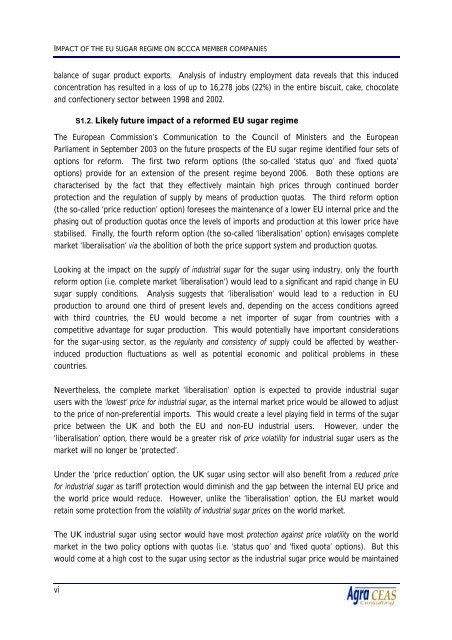2205 final report.pdf - Agra CEAS Consulting
2205 final report.pdf - Agra CEAS Consulting
2205 final report.pdf - Agra CEAS Consulting
Create successful ePaper yourself
Turn your PDF publications into a flip-book with our unique Google optimized e-Paper software.
IMPACT OF THE EU SUGAR REGIME ON BCCCA MEMBER COMPANIES<br />
balance of sugar product exports. Analysis of industry employment data reveals that this induced<br />
concentration has resulted in a loss of up to 16,278 jobs (22%) in the entire biscuit, cake, chocolate<br />
and confectionery sector between 1998 and 2002.<br />
S1.2. Likely future impact of a reformed EU sugar regime<br />
The European Commission’s Communication to the Council of Ministers and the European<br />
Parliament in September 2003 on the future prospects of the EU sugar regime identified four sets of<br />
options for reform. The first two reform options (the so-called ‘status quo’ and ‘fixed quota’<br />
options) provide for an extension of the present regime beyond 2006. Both these options are<br />
characterised by the fact that they effectively maintain high prices through continued border<br />
protection and the regulation of supply by means of production quotas. The third reform option<br />
(the so-called ‘price reduction’ option) foresees the maintenance of a lower EU internal price and the<br />
phasing out of production quotas once the levels of imports and production at this lower price have<br />
stabilised. Finally, the fourth reform option (the so-called ‘liberalisation’ option) envisages complete<br />
market ‘liberalisation’ via the abolition of both the price support system and production quotas.<br />
Looking at the impact on the supply of industrial sugar for the sugar using industry, only the fourth<br />
reform option (i.e. complete market ‘liberalisation’) would lead to a significant and rapid change in EU<br />
sugar supply conditions. Analysis suggests that ‘liberalisation’ would lead to a reduction in EU<br />
production to around one third of present levels and, depending on the access conditions agreed<br />
with third countries, the EU would become a net importer of sugar from countries with a<br />
competitive advantage for sugar production. This would potentially have important considerations<br />
for the sugar-using sector, as the regularity and consistency of supply could be affected by weatherinduced<br />
production fluctuations as well as potential economic and political problems in these<br />
countries.<br />
Nevertheless, the complete market ‘liberalisation’ option is expected to provide industrial sugar<br />
users with the ‘lowest’ price for industrial sugar, as the internal market price would be allowed to adjust<br />
to the price of non-preferential imports. This would create a level playing field in terms of the sugar<br />
price between the UK and both the EU and non-EU industrial users. However, under the<br />
‘liberalisation’ option, there would be a greater risk of price volatility for industrial sugar users as the<br />
market will no longer be ‘protected’.<br />
Under the ‘price reduction’ option, the UK sugar using sector will also benefit from a reduced price<br />
for industrial sugar as tariff protection would diminish and the gap between the internal EU price and<br />
the world price would reduce. However, unlike the ‘liberalisation’ option, the EU market would<br />
retain some protection from the volatility of industrial sugar prices on the world market.<br />
The UK industrial sugar using sector would have most protection against price volatility on the world<br />
market in the two policy options with quotas (i.e. ‘status quo’ and ‘fixed quota’ options). But this<br />
would come at a high cost to the sugar using sector as the industrial sugar price would be maintained<br />
vi













